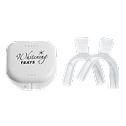Toenail fungus can cause discomfort and embarrassment, especially when it affects multiple toenails. It is important to understand the symptoms of toenail fungus to seek appropriate treatment and prevent further complications.
Toenail fungus, also known as onychomycosis, is a common fungal infection that affects millions of people worldwide. It is a fungal infection that can occur on the toenails, fingernails, and skin and is caused by a group of fungi called dermatophytes, which thrive in warm and moist environments such as public showers, swimming pools, and locker rooms.
In this SwissKlip blog post, we will explore the causes, signs, and prevention of toenail fungus to help you keep your feet healthy.
Causes of Toenail Fungus
Toenail fungus is caused by a group of fungi called dermatophytes, which can also cause athlete’s foot and jock itch.
These fungi thrive in warm, moist environments, such as public showers, swimming pools, and locker rooms.
They can also be spread from person to person through direct contact or by sharing nail clippers, shoes, or socks.
Certain factors can increase your risk of developing toenail fungus. These include age, diabetes, weakened immune system, nail trauma, and athlete’s foot.
Older adults are more susceptible to toenail fungus due to decreased blood flow, slower nail growth, and weaker immune systems.
People with diabetes have a higher risk due to poor circulation and weakened immune systems. A weakened immune system can also lead to a higher risk of developing toenail fungus.
Injuries to the toenails or skin around the toenails can create an entry point for fungi, and athlete’s foot can spread to the toenails, leading to toenail fungus.
Toenail Fungus Symptoms
The symptoms of toenail fungus can vary depending on the severity of the infection. Common toenail fungus symptoms include:
Thickened nails
Thickened nails are one of the common symptoms of toenail fungus. If you have toenail fungus, you may notice that your toenail has become thicker than usual.
In some cases, the nail may become so thick that it becomes difficult to trim with regular nail clippers. It is suggested to use toe nail clippers specially designed for this purpose.
The thickness of the nail can be caused by the accumulation of fungus and debris underneath the nail.
As the infection progresses, the nail may become more distorted in shape, with ridges, bumps, or other irregularities.
In severe cases, the nail may even separate from the nail bed. Thickened nails can be uncomfortable and make it difficult to wear shoes, especially if the nail has lifted away from the nail bed.
Early diagnosis and treatment can prevent further complications and help manage the condition effectively.
Discolored nails
Discolored nails are another common symptom of toenail fungus. If you have toenail fungus, you may notice that your toenail has changed color.
The nail may turn yellow, brown, or even black. The discoloration can also be accompanied by a loss of shine, making the nail appear dull.
The discoloration is caused by the accumulation of debris underneath the nail, which is a common characteristic of toenail fungus.
The debris can include dead skin cells, nail tissue, and fungal material. As the infection progresses, the discoloration may spread across the entire nail, making it difficult to hide.
In some cases, the discoloration may be mistaken for a bruise or injury.
However, if the discoloration persists or worsens, it is important to seek medical attention or look for the best nail fungus treatment.
Your podiatrist can perform a physical exam and order a nail culture test to confirm the presence of toenail fungus. Read this Toenail Fungus Cure guide to know more about toenail fungus cure options.
Brittle, crumbly, or ragged nails
Brittle, crumbly, or ragged nails is one of the common toenail fungus symptoms. If you have toenail fungus, you may notice that your toenail has become brittle, crumbly, or ragged. The nail may break easily and may not grow as fast as it used to. In severe cases, the nail may even separate from the nail bed.
This toenail fungus symptom is caused by the fungal infection damaging the nail bed and the matrix, which is responsible for nail growth. As a result, the nail becomes weaker and more prone to breakage. The nail may also become thinner than usual, making it more susceptible to damage.
If left untreated, the brittle, crumbly, or ragged nail can become painful and make it difficult to wear shoes or walk comfortably.
Distorted shape
Distorted nail shape is another common toenail fungus symptom. If you have toenail fungus, you may notice that your toenail has become distorted in shape.
The nail may have ridges, bumps, or other irregularities. In some cases, the nail may become curved or twisted.
This toenail fungus symptom is caused by the fungal infection damaging the nail bed and the matrix, which is responsible for nail growth.
As a result, the nail grows abnormally, causing it to become distorted in shape. The distorted shape can be uncomfortable and make it difficult to wear shoes, especially if the nail has lifted away from the nail bed.
In severe cases, the nail may even separate from the nail bed, which can be painful and increase the risk of infection.
Foul odor
Foul odor is one of the toenail fungus symptoms. If you have toenail fungus, you may notice a strong odor emanating from your affected toenail. The odor is caused by the accumulation of fungus and debris underneath the nail, which can create a moist and warm environment for bacterial growth.
The bacteria can produce a strong and unpleasant odor that is difficult to ignore. In addition to causing embarrassment, the foul odor can be an indication of a more serious infection.
Additionally, practicing good foot hygiene and keeping your feet clean and dry can help prevent the accumulation of debris and bacteria, reducing the risk of foul odor.
Diagnosis of Toenail Fungus
Toenail fungus can be diagnosed through a physical examination and laboratory tests. During the physical exam, your podiatrist will inspect your toenails and surrounding skin for signs of infection.
They may also ask you about your medical history and any medications you are taking, as certain medications can increase your risk of developing toenail fungus.
To confirm the presence of toenail fungus, your podiatrist may order a nail culture test. This test involves taking a small sample of the affected toenail and sending it to a laboratory for analysis.
The sample is examined under a microscope or cultured to determine the type of fungus causing the infection.
Other diagnostic tests, such as a KOH (potassium hydroxide) test or a fungal DNA test, may also be used to diagnose toenail fungus.
These tests are less commonly used but may be recommended in certain cases.
It is important to seek medical attention if you suspect you have toenail fungus. Early diagnosis and treatment can prevent further complications and help manage the condition effectively.
Treatment of Toenail Fungus
Toenail fungus can be treated with several different types of therapies, including oral and topical medications, laser therapy, and surgical removal of the affected toenail. Your podiatrist can recommend the best treatment option for your specific case.
Oral antifungal medication
Oral antifungal medications are often used to treat toenail fungus. These medications are taken by mouth and work by killing the fungi responsible for the infection. Treatment typically lasts several months, and the medication must be taken consistently to be effective. Oral antifungal medications can have side effects and may interact with other medications, so it is important to talk to your healthcare provider about any concerns.
Topical antifungal medication
Topical antifungal medications are another option for treating toenail fungus. These medications are applied directly to the affected toenail and surrounding skin. They are typically used in conjunction with other therapies, such as oral medication, for more severe cases of toenail fungus.
Laser therapy
Laser therapy is a newer treatment option for toenail fungus. The laser emits a beam of light that penetrates the toenail and destroys the fungi responsible for the infection. Laser therapy is considered safe and effective, but may not be covered by insurance and can be more expensive than other treatments.
Surgical nail removal
In severe cases of toenail fungus, surgical removal of the affected toenail may be necessary. This procedure is typically performed under local anesthesia and involves removing the entire toenail or just the affected portion. While this option can be effective, it can also be painful and require a lengthy recovery period.
Prevention of recurrence
Preventing recurrence of toenail fungus is also an important part of treatment. Your podiatrist may recommend practicing good foot hygiene, wearing clean and dry socks, and avoiding public areas barefoot to prevent reinfection. They may also recommend using antifungal sprays or powders on your feet and shoes to reduce the risk of recurrence.
Prevention of Toenail Fungus
Preventing toenail fungus is important for maintaining healthy feet. There are several steps you can take to reduce your risk of developing toenail fungus, including:
Keep your feet clean and dry
Wash your feet daily with soap and warm water, and dry them thoroughly, especially between the toes.
Wear clean and dry socks
Change your socks daily, and avoid wearing the same pair of shoes for consecutive days.
Wear shoes in public areas
Wear shoes or sandals in public areas, such as locker rooms, swimming pools, and showers, to reduce your risk of exposure to fungi.
Use antifungal sprays or powders
Apply antifungal sprays or powders to your feet and shoes to reduce the risk of infection.
Trim your toenails regularly
Keep your toenails trimmed and clean to reduce the risk of fungal infection.
Avoid sharing personal items
Do not share nail clippers, socks, or shoes with others, as this can increase your risk of infection.
Treat athlete’s foot promptly
If you develop athlete’s foot, treat it promptly to prevent the infection from spreading to your toenails.
By following these simple steps, you can reduce your risk of developing toenail fungus and maintain healthy feet. If you suspect you have toenail fungus, it is important to seek medical attention to prevent further complications and manage the condition effectively.
Managing Toenail Fungus Symptoms
Toenail fungus is a common and often embarrassing condition that can affect anyone. If left untreated, toenail fungus can lead to complications and make it difficult to wear shoes or walk comfortably.
The symptoms of toenail fungus can vary, but often include thickened nails, discolored nails, brittle or ragged nails, distorted nail shape, and foul odor. If you suspect you have toenail fungus, it is important to seek medical attention for diagnosis and treatment.
Treatment options for toenail fungus include oral and topical medications, laser therapy, and surgical removal of the affected toenail. Your podiatrist can recommend the best treatment option for your specific case.
Preventing toenail fungus is also important for maintaining healthy feet. Practicing good foot hygiene, wearing clean and dry socks, and avoiding public areas barefoot can reduce your risk of developing toenail fungus.
By taking steps to prevent and treat toenail fungus, you can maintain healthy feet and prevent further complications. If you have any concerns about toenail fungus or other foot conditions, speak to your podiatrist for guidance and treatment.

































